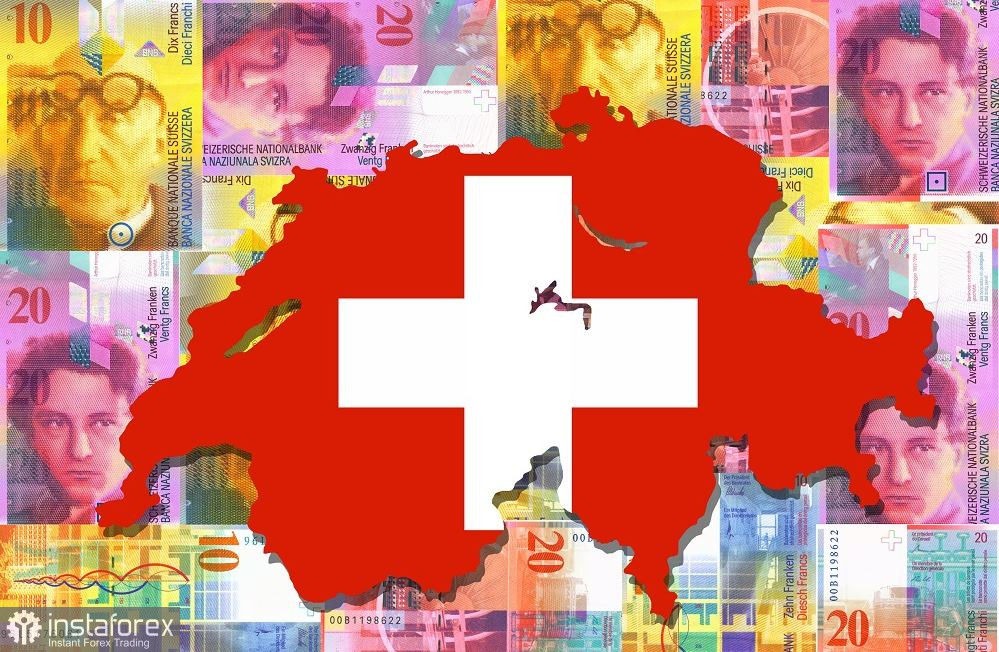The Swiss National Bank only meets four times during the calendar year. Therefore, each SNB meeting is an important event for USD/CHF traders. For instance, the central bank suddenly raised its policy rate by half a percent in June. It happened for the first time since 2007, i.e. for the first time in 15 years. The central bank thus tried to reduce the inflationary pressure on the country.
But despite the measures taken, inflation in Switzerland was still positive, so the SNB took the unprecedented step of ending nearly eight years of negative rates. The central bank raised the rate from -0.25% to 0.5%. Recall that negative rates in Switzerland were introduced in December 2014 as a protective measure: the SNB tried to prevent an appreciation of the national currency by discouraging foreign investment in the Swiss currency, but at the same time facilitating consumption. The measure, in theory, was designed to encourage banks and investors to inject free capital into the economy rather than keeping it in the account. Deflation and the strengthening of the franc was a "headache" for the SNB, which repeatedly warned (frightened) investors with currency intervention.

Today, however, the situation has changed dramatically. Inflation in Switzerland is now at its highest level in almost 30 years, so protecting the strong franc is no longer a priority. Rising inflation in the country is now a key concern for the SNB.
Having raised its interest rate by 75 points in September, the Swiss central bank made it clear that further hikes "cannot be excluded". In other words, the SNB said the hawkish decisions were unprecedented and to some extent extraordinary.
The SNB's updated forecasts in September suggested that after two interest rate hikes, Swiss inflation would likely fall to the target 2% level (if not lower), "at the end of the forecast horizon." Such language in the accompanying statement implicitly indicated that the SNB had done enough to return inflation to the target level for the foreseeable future. At least that's how traders interpreted the results of the September meeting. The pair rose 500 points in a few weeks and then another 300 points above parity.
But then the bears seized the initiative: since the beginning of November, the franc strengthened by more than 800 points, going down from 1.0130 to the current value of 0.9341. It happened not only at the expense of the dollar weakening, but also at the expense of the franc strengthening. The inflation report, published last week, added more fuel to the fire: contrary to expectations of many experts, inflation growth has not slowed down in Switzerland.
According to the report, the consumer price index in Switzerland rose by 3% in November, the same as in the previous month. This fact disproved the assumptions of the SNB economists about the slowdown of inflation growth. There are no signs of a slowdown in CPI today.
And here traders recalled another phrase from the September SNB meeting - that the central bank did not rule out further interest rate hikes. Hawkish speculation was fueled by SNB Vice President Martin Schlegel, who on December 1 made it clear that the central bank will not sit idly by and do nothing, but "continue to take measures against excessively high levels of inflation". Earlier another Swiss central bank representative, Andrea Maechler, said that the SNB could hike interest rates again. According to her, Swiss inflation remains "too high," so to ensure price stability in the medium term "it may be necessary to further increase rates".
Let me repeat: the SNB holds its meetings only four times a year. In 2022, at the end of two of them (in June and September), the central bank increased the interest rate in response to rising inflation in the country. However, inflation is still well above the 2% inflation target, so the SNB might well take another step in the direction of hiking the rate by 50 or 75 points in December. The issue is debatable, so a hawkish decision from the central bank would be a strong support for the franc. It suggests that the downtrend might continue for the pair.
Technically speaking, the pair is in a descending channel. It demonstrates the downtrend, which is confirmed by the Ichimoku indicator, which formed its bearish "Parade of Lines" signal on the daily chart. Also, the price is between the middle and bottom lines of the Bollinger Bands indicator on some "higher" charts (D1, W1, but except MN), which is in an extended channel. The support level (the target of the downward movement) is the bottom line of the Bollinger Bands indicator on the weekly chart, which corresponds to 0.9250. In this price area, it will be best to lock in profits and take a wait-and-see position.





















